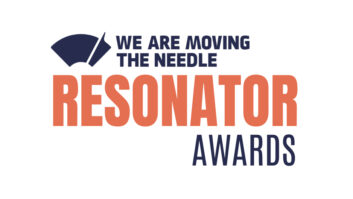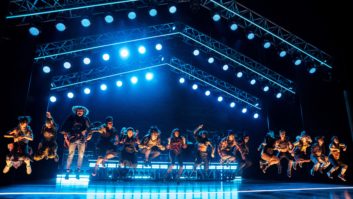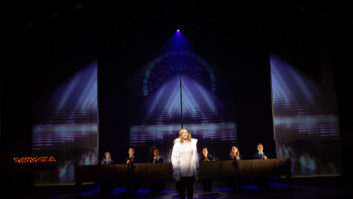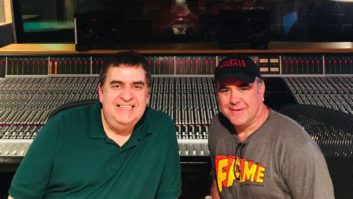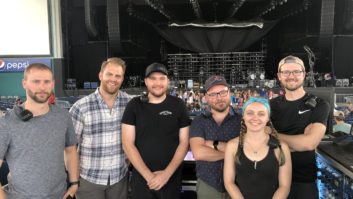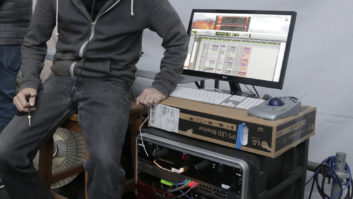In 1995, Alanis Morissette released Jagged Little Pill, which went on to become one of the best-selling records ever by a solo artist. The disc sold over 15 million copies in the U.S. alone, and over 30 million worldwide. Blending heartfelt, honest lyrics with blistering rock grooves, Morissette became an icon with confrontational songs like “You Oughta Know” and the whimsical “Ironic.” Her follow-up record, the more introspective Supposed Former Infatuation Junkie, while not achieving the success of her debut, still sold a respectable 2.5 million copies in the U.S. and close to 10 million worldwide. Her current release, Under Rug Swept, debuted at Number One on the Billboard charts. The CD mixes some “Jagged-like” tunes such as “12 Things I Look For In a Lover” and “Hands Clean” with beautiful ballads like “Flinch.”
BEARING AN ARENA-SIZED CROSS
On her current tour, Morissette is playing mid-sized venues, often hockey arenas, like Denver’s 6,500-seat Magness Arena, which presents an interesting challenge for FOH engineer Terry Pearson. Pearson, an independent engineer, spent 10 years engineering for Sonic Youth and five years engineering for Beck, which is how he ended up getting the gig with Alanis. “Andy Proudfoot, the tour manager for Alanis, worked with me when I was with Beck, so that was the connection that got me in with Alanis. Most recently, before working with Alanis, I toured with REM, Pete Yorn and David Byrne.”
For this tour, Pearson is using a Midas XL4 console. “I prefer Midas consoles,” he says. “The last couple of tours I worked on, I took a Heritage 3000 out, but for this one, I think the XL4 is a little more precise and has more features. It has lowpass as well as a highpass filters. The automated features let me turn off gates, auxes and mutes for each song, allowing for a less-tactile approach with the console. The automation also gives you a VCA gain reference for each song. Alanis is varying the set list for each show from a list of about 30 songs, and I have programmed scenes for each of them. The VCAs allow me to use one fader to push the band up and one to push up Alanis. I’m using a total of 34 inputs on the console.”
Though Pearson uses the XL4 mic pre’s for most of the microphones onstage, for Alanis’ vocal channel, he uses an Avalon VT737SP tube compressor/mic pre for more accuracy. “I route that into a BSS DPR-901 II selectable-frequency compressor. Then I have a Klark-Teknik DN410 Parametric EQ that I assign to the vocal group on the Midas, so I can EQ specifically for her voice. Alanis writes all of her lyrics, and I think people come to the show to hear those lyrics, so I try to mix so that [the lyrics] are on top and out front and intelligible. She is a wonderful singer and really carries the show with her voice. However, she doesn’t sing very loudly, and because of that, her vocal mic has a lot of gain, and she moves all over the stage, so you pick up stage volume through the vocal mic, which is the biggest challenge in mixing the show.”
For effects, Pearson uses a variety of multi-effects units to help create different sonic textures. “I have a TC M5000 multi-effects unit, a Lexicon 480L reverb, a [Yamaha] SPX-990 multi-effects, a PCM 42 delay and an Eventide H3000 Harmonizer. On Alanis’ CDs, she overdubs her voice a lot to create harmonies and textures, so I use a variety of delays and the harmonizer to create different textures between the verses and the chorus. But [I] keep it sounding natural to imply the effect that she uses on the CDs.
“I use six dbx 160A compressors for the bass and acoustic guitars, then two dbx 160XT for the kicks and snares, coupled with four Drawmer DS201s stereo gates so you have a gate/compressor setup there, where the signal goes into the Drawmers then into the 160XTs. I also have a Drawmer 1960 tube compressor that I use on the guitars. I also use a dbx 1046 compressor; I use two lines for the keys and two for the stereo Leslie inputs.”
Despite current trends, Alanis’ band still prefers to play through amplifiers onstage instead of using isolated cabinets offstage or DIs. Pearson uses a variety of different microphones to get everything through the P.A. “Each of the guitar cabinets is miked with a Sennheiner 409. On stage right, there is one Marshall 4×12 cabinet and a Fender 1×12, which is used for effects and loops. Alanis uses a Fender 4×10. On stage left, there is a Divided by 13 and a Matchless amp, which are both 2×12s.” For the keys and bass, Pearson uses Countryman DIs as well as mics. “The DIs are used on two key lines, the loops and three acoustic guitars. On keys, I have a Sennheiser 421 on the low Leslie cabinet and a stereo pair of Shure SM81s on the highs. The keyboardist has a submixer so that he does the effects loops onstage and then sends me stereo lines. The bass has a Shure SM98 on the Ampeg bass cabinet in addition to the Countryman.” Alanis sings and plays harmonica into an Audix VX10.
The drum setup is relatively simple. “There are two kick lines; one is an SM91 and one is Shure B52. I have a Shure Beta 56 for snare top bottom, an AKG 460 for the hi-hat, and three SM98s on the rack and the two floor toms. The drummer also uses a djembe [hand drum], which is miked with an E-V 408 underneath. There is a second snare with an SM56 on it. The overhead mics are AKG 414s, and the ride is another 405.”
On this tour, Morissette is carrying her own P.A. Like many rock acts, they have switched to a line array system. “It’s a Clair Brothers I4 line array system that is controlled by the new Clair IO controller. Each zone has four speakers. We have four I4 speakers run at a 2.5-degree angle that go up in the upper reaches, four at a 5-degree spread for the middle of the room and four at 10 degrees for the bottom. There are also six flown I4B subs and four 2×18 S4 subs on the floor per side. The IO controller lets us manipulate each speaker with individual delay time, gain and EQ to tailor it to the best coverage for the venue. The controller is wireless; it is a computer screen that you can carry anywhere in the venue to make your changes wherever and whenever you want. I also have a Klark-Teknik DN6000 Analyzer to get a readout of how the frequencies are reacting in the room to isolate problem areas. We fly the P.A. for every show. My system engineer walks the room after the show starts and suggests adjustments for each zone to smooth it out. During soundcheck, I do a walk-through to get the initial setup done.”
THANK YOU SILENCE
On this tour, there have been a variety of monitor engineers. At the Denver show, Glen Collett of Clair Brothers and a veteran of tours with Bette Midler, Bryan Adams, Paul Simon, Mariah Carey, Julio Iglesias and most recently ‘N Sync was handling monitors. “I happened to be home and have time to do this part of the tour. I came out for four dates on Alanis’ tour. Randy Bryant, who has done monitors for her on several of her prior tours, will be coming back on tour after I leave; he had some other commitments and couldn’t do the first part of the tour.”
Collett is mixing using a Midas XL3 desk. Clair brothers has provided 12AM wedges for use as monitors by most of the musicians. “The stage-right guitarist has a pair of the 12AMs. He gets lots of guitar, both his and the other guitarist’s, plus a little drums and some of Alanis’ vocals. The other guitarist also has a pair of 12AMs. He gets a general band mix with his guitar a little bit on top. The bassist is in the center and has a pair of 12AMs, also. He gets bass, guitars and Alanis’ vocal, as well as some kick drum. The keyboardist gets a pair of 12AMs running in stereo. He gets everything in the mix, with everything he plays on top. The drummer has a pair of 12AMs and a Clair Brothers ML-18 sub-bass. He has the entire band in his mix with drums on top.”
While everyone in the band uses wedges, Alanis prefers in-ear monitors (IEMs). “She uses Ultimate Ears UE-5s,” says Collett. “Alanis only has her vocals in her mix. She sings very quietly. She likes the band very close to her so a lot of the stage volume bleeds into the mic, so you can’t put anything else in there without it getting very messy.”
Candace Horgan is a freelance writer based in the Denver area.
